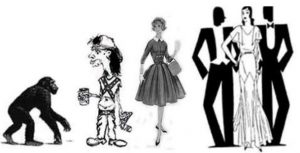
The theory that persons, groups, and races are subject to the same laws of natural selection as Charles Darwin had perceived in plants and animals in nature. According to the theory, which was popular in the late 19th and early 20th centuries, the weak were diminished and their cultures delimited, while the strong grew in power and in cultural influence over the weak. Social Darwinists held that the life of humans in society was a struggle for existence ruled by “survival of the fittest.” These ideas were embraced by the turn-of-the-century elites confronting the challenges of how to transform their “backward,” underdeveloped nations into modern, “civilized” republic.
_______________________________________________________________________________________________________________________________________
In the article “Is Everywhere Nowhere? Nomads, Nations, and the Immigrant Paradigm of the United States History,” author Donna Gabaccia makes and important reference to the theory of Social Darwinism. She writes:
Curiously, however, the immigrant paradigm of American history is not a product of immigration history; it originates in a critique of racial nationalism within the Chicago School of Sociology. Rejecting social Darwinist notions that an over-heated melting pot was unable to absorb immigrants from eastern and southern Europe, the Chicago School documented immigrants’ rapid “straight-line” assimilation in American cities.
In previous studies of race and ethnicity in Latin America, I have examined the theory and effects of Social Darwinism from a historical standpoint, but I never thought to considered its connection with US’s immigrant paradigm. For myself, I often get caught up in the study of “history” as facts and events without taking the time to relate it to the present. The idea of “survival of the fittest” is still alive and strong in our society and for many is quite ingrained in our subconscious thought. The spread of Social Darwinism plays a huge role in how we compare the nations, lives, culture, and migration of non-Western European nations (primarily) in to our own. In moving forward in our local study of migration I feel it will benefit us to consider the theory of Social Darwinism in our community.
- What role did Social Darwinism play in the formation of Stevens County?
- Why is the question of Social Darwinism important to our research?
- Does this theory impact/exist in our community today ?
- By whom and how are these ideas, consciously or unconsciously, perpetuated?
- Does Social Darwinism play any part in the current connection between the migration of the past and the migration of the present?
Gabaccia, Donna R. “Is Everywhere Nowhere? Nomads, Nations, and the Immigrant Paradign of the United States History.” The Journal of American History, 1999.
Leave a Reply